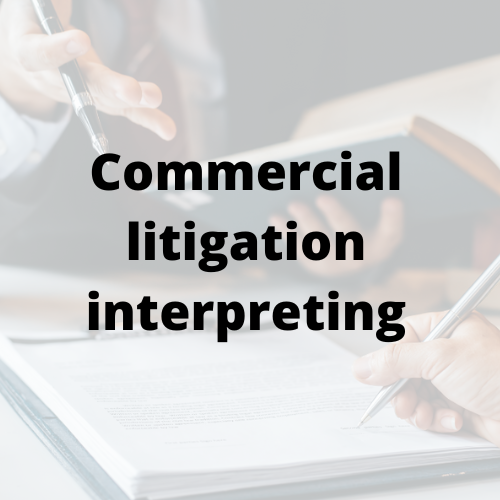4 things UK certified translators must NOT do
When I first started as a certified translator in the UK, I found myself wondering what exactly I could and could not do to meet the requirements. I had to research quite a bit! Within this post, I delve into four actions that UK certified translators are prohibited from undertaking and how to approach these issues with the client:
Amending Errors
If an error is present in the original document, it must also be replicated in the translated version. Whether it involves a numerical discrepancy, a misspelled name, or content that shouldn't be there in the first place, rectification should be carried out by an authorised individual prior to translation.
Always ask clients if they have read their documents and confirm that they are happy with everything, as no amendments can be made by the translator, even if we know something is wrong in the original for whatever reason.
I've encountered a few instances to exemplify this:
A client who had undergone naturalisation supplied me with their child's birth certificate, erroneously indicating that they, the parent, had also been born in the country of their nationality. They hadn't reviewed the document before leaving the Register Office. The Portuguese phrase used was ‘natural de’, meaning birthplace. I explained to them that the original document needed to be corrected by the registrar, clerk or, as this was in Brazil, possibly the court before I could proceed with a different translation.
I also worked on an academic transcript that displayed multiple miscalculations of a client's GPA. Once the client highlighted these inaccuracies, I had to explain that, regrettably, I couldn't rectify them. Instead, I proposed that they reached out to the university.
Copying Content
A certified translation is an accurate rendition of the original document in another language, encompassing all components such as tables, graphs, signatures, stamps, seals, logos, etc. Ideally, these elements should be placed in corresponding locations as in the original document to facilitate comparison. However, we are not authorised to simply include these elements in the translated version.
As a rule, for logos and pictures, it is enough to mention their presence on the page and what they feature/say. The only situation where copyright content may be copied is when the logo or image owner grants permission. If such permission is granted, add a translator's note to clarify that the logos/pictures on the document aren't your own. Certified translations are intended to accompany the original, not to serve as a substitute. Therefore, people will still get to see the logo or pictures in the original.
Never copy and paste stamps or seals though. For these, the correct practice is to create a text box in the same location as the original and translate their content. If it is round, you might even add a circle with the text inside. Use [].
Regarding signatures, we should write [signature] in the same place as the original (you can even use a different font’), but we must refrain from including a screenshot of it, as the original signer will not have endorsed the translation. There could be misinterpretation/misrepresentation arising from this.
Omitting Information
Even if a form contains empty fields or the client solely requires the certified translation for proof of address, all content from the original must be included.
Clients may turn up with lengthy bank statements with intricate tables of which all they need is the proof of address. In such cases, I recommend trying to find a shorter document for cost efficiency.
One thing we cannot do is translate only what the client wants. Deciding on information relevance isn't within our scope of work as translators or that of the clients’. The responsibility for verifying the document rests with those in authority. Additionally, if the translation significantly differs, or is considerably shorter, doubts will arise regarding its fidelity to the original document.
If any section of the original document has indecipherable text or erasures, these issues must be noted in the same location as they appear in the original document.
Beware: some things (such as cultural specific items) do get lost in translation. If, say, a document has a mistake in Portuguese spelling, do NOT purposely make a spelling mistake in the English version. In fact, some errors in one language do not equate to or even happen in the other. In that case, just use the correct translation and, if it is really relevant, add a footnote. Intelligibility goes above all.
One of the most important steps is asking the client what they need the document for. In my practice, I favour the client receiving the service they need above my profit per se, so I might turn down a client or suggest they find a shorter document.
Adding Information
The same principles governing omissions apply to additions.
Certified translators must not add their own ideas into the text, but we may sparingly add footnotes; basically avoid them as much as you can.
Some additions are permitted and useful if they do not change the meaning. You know, the translator is not a parrot, therefore one does not have to and should not translate word-for-word.
Here are a few examples:
One tricky thing specific to Portuguese in comparison to English is gender. All nouns are gendered. If a person’s gender is not specified, I either:
a. find a way to make it clear that it could be male or female, or add both the feminine and masculine. For instance: doctor = médico(a). In this case, I might add a footnote to explain that the translator did not know whether the individual was male or female. This can make a difference in a court case, for instance, so I would not use the default masculine in Portuguese, nor would I use gender neutral language as it is not the norm with legal documents. If the text is in Portuguese and I translate into English, I may add male or female before the word doctor depending on context.
b. use something more general that means the same thing when possible. If a document says someone is X’s friend, I will write ‘pessoa com quem X tem uma relação de amizade’ (person with whom X has a friendship), as person is used for both genders. This adds more words, but does not change the meaning.
c. Often with court cases, I know the genders of the individuals involved as I do the full translation workload for the solicitors and will also interpret for them. Where I don’t, if I think it is relevant, I simply ask. If I can’t get the information, I go back to solution a. For words like child and sibling I always confirm genders as I do not want the Portuguese speaking person to find my translation unreliable.
Anything else you would add?




